Ultrasonic peeling: what is it?
- What is ultrasonic peeling?
- How does cavitation peeling work?
- What effects does ultrasonic peeling provide?
- For whom is ultrasonic peeling recommended?
- What are the contraindications for cavitation peeling?
- How to perform an ultrasonic peeling at home?
- How to take care of the skin after cavitation peeling?
What is ultrasonic peeling?
Ultrasonic peeling is a painless and non-invasive procedure that uses ultrasound to deeply cleanse the skin and gently exfoliate dead skin cells. It is a modern alternative to traditional methods such as mechanical peels, enzymatic peels, or microdermabrasion.
This treatment effectively eliminates dead cells, excess sebum, all impurities, and even bacteria. As a result, the skin becomes visibly cleaner and refreshed.
Although ultrasonic peeling is often performed by cosmetologists, you can also do it yourself at home using a special device.
- Cavitation peeling is a treatment utilizing the phenomenon of cavitation, induced by ultrasonic waves. When the device emitting ultrasonic waves contacts moist skin, microscopic gas bubbles are formed, which rapidly burst under pressure. This process acts on the skin, providing many benefits:
- removes dead skin cells,
- reduces excess sebum,
- eliminates all impurities,
- gently massages the skin, improving circulation,
- has a disinfecting effect, helping to eliminate bacteria and toxins from the skin's surface.
Cavitation treatment is often complemented with sonophoresis, which, using the same waves, effectively introduces active ingredients into deeper skin layers.
Ultrasonic peeling is an effective treatment that deeply cleanses and gently massages the skin, bringing a range of benefits. It efficiently unclogs and tightens pores while reducing blackheads.
This treatment stimulates the production of collagen and elastin, allowing the skin to regain firmness and elasticity. As a result, fine lines become less visible, and the skin appears younger and healthier.
The micromassage, which is an integral part of the peeling process, significantly improves circulation, supporting cellular metabolism. This, in turn, intensively oxygenates and nourishes the skin, enhancing its condition.
After the treatment, the skin becomes incredibly smooth, fresh, and regains its natural, radiant glow. Regular sessions bring additional effects:
- improve the absorption of active ingredients from cosmetics,
- help lighten discoloration,
- help minimize scars,
- improve the appearance of the skin,
- support overall skin regeneration.
Ultrasonic peeling is an extremely versatile treatment that effectively cleanses and regenerates the skin. Due to its gentleness, it is also safe for sensitive, thin, or vascular skin.
It is an excellent solution for many skin types, including:
- oily,
- combination,
- acne-prone,
- mature,
- tired,
- sensitive,
- thin,
- vascular.
Cavitation peeling, although usually safe, cannot be performed on everyone. Significant contraindications to the procedure include:
-
pregnancy and breastfeeding,
-
cancer diseases,
-
epilepsy,
-
osteoporosis,
-
circulatory insufficiency,
-
thyroid disorders,
-
general weakness of the body, including fever.
An absolute contraindication to the procedure is also the presence of a heart pacemaker and metal implants, especially in the area undergoing treatment. Contraindications to cavitation peeling also include:
-
active skin infections (bacterial, viral, fungal),
-
active rosacea,
-
open wounds,
-
abrasions,
-
skin inflammations.
Always consult a doctor or experienced cosmetologist before the procedure to ensure that cavitation peeling is safe for you.
To properly perform a home cavitation peeling, follow the guidelines below.
- Thoroughly cleanse the skin, preferably with micellar water.
- Thoroughly moisten the skin - you can use water, tonic, or a special conducting gel - it is important for the skin to remain moist throughout the treatment.
- Turn on the peeling device and gently move the spatula over the moist skin, keeping it at a 45-degree angle.
- Remember to use centrifugal movements to effectively cleanse the skin.
- After the treatment, remove any remaining cosmetics and proceed with further skincare.
- Also, remember to regularly disinfect your equipment.
Adjust the frequency of treatments according to your skin type: oily skin can undergo cavitation 1-2 times a week, while dry or sensitive skin needs it much less often - every 3-4 weeks.
After a cavitation peeling treatment, regardless of whether it was done at home or in a salon, proper skin care is crucial. It will help maintain the achieved results and at the same time soothe skin irritations.
Immediately after the treatment, the skin may be slightly red. For several days, avoid sun exposure at all costs and always use a high SPF sunscreen (minimum 30, preferably 50) to prevent the formation of discoloration.
Intensive moisturizing of the skin after the treatment is essential as it helps rebuild the skin's natural protective barrier. Reach for gentle but rich in moisturizing ingredients cosmetics, such as specialized creams or serums. A soothing algae mask will also be an excellent addition to the skincare routine.
When looking at the ingredients of cosmetics, search for soothing and regenerating components such as panthenol, ceramides, centella asiatica, or bakuchiol. For at least a few days, strictly avoid other peels and any invasive treatments that could irritate the freshly cleansed skin.

